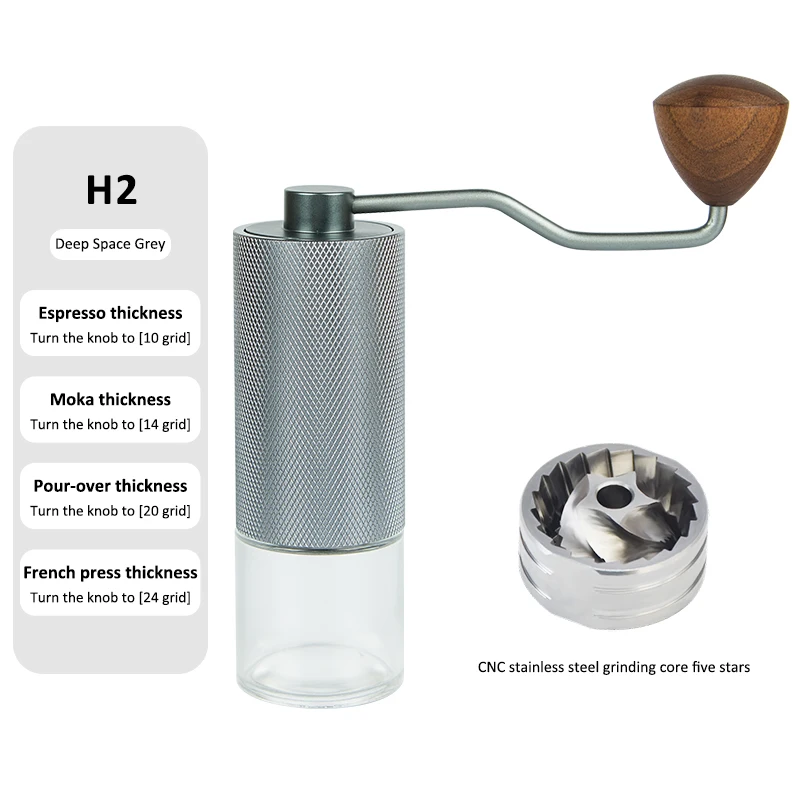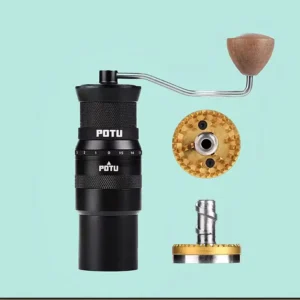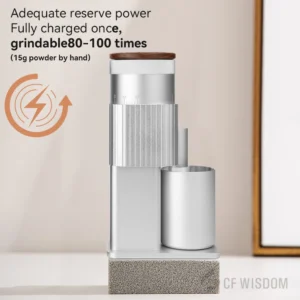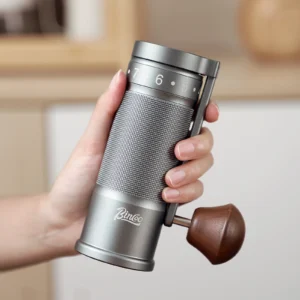The Unmatched Quality of Freshly Ground Coffee While Traveling
There’s a reason coffee enthusiasts insist on grinding beans just before brewing – science is firmly on their side. When coffee beans are ground, they immediately begin losing the volatile compounds that create that irresistible aroma and complex flavor. Within just 15 minutes after grinding, coffee loses up to 60% of its aromatic compounds through oxidation.
The difference between pre-ground and freshly ground coffee is immediately noticeable to your senses:
- Aroma: Fresh grounds release a robust, multi-dimensional scent that fills the room – something pre-ground coffee simply cannot match
- Flavor: Freshly ground coffee preserves delicate notes like fruitiness, chocolate, or nutty undertones that rapidly fade in pre-ground options
- Body: The mouthfeel of freshly ground coffee is noticeably richer and more satisfying
- Complexity: The subtle layers of flavor that make specialty coffee special remain intact only with fresh grinding
This isn’t just coffee snobbery – it’s chemistry. Coffee contains over 800 aromatic compounds that begin deteriorating immediately after grinding. Understanding these precision grind settings is essential for extracting the full potential from your beans.
Thankfully, the portable coffee grinder market has evolved dramatically in recent years, offering travelers solutions that don’t compromise quality. Today’s mobile options deliver grind consistency that rivals many home grinders while fitting easily into a backpack or suitcase.
Understanding Your Mobile Coffee Needs
Before diving into specific grinder recommendations, it’s important to identify your particular “on-the-go” coffee requirements. Different travel scenarios demand different features in a portable grinder.
The Office Professional
You need a grinder that operates quietly enough for an office environment and won’t create mess or distraction. Size matters less than cleanliness and discretion, with moderate capacity for daily use.
The Frequent Traveler
Your priority is ultra-compact design and lightweight construction. TSA compatibility is essential, which means avoiding certain electric options with lithium batteries. Durability for constant packing and unpacking is crucial.
The Outdoor Enthusiast
You require exceptional durability to withstand rough handling and possibly wet conditions. Power access is limited or non-existent, making reliability without electricity essential. Weight matters, but ruggedness matters more.
The Home-to-Go User
You want versatility between home countertop use and occasional travel. Capacity and efficiency are important, as is the ability to handle multiple brewing methods with different grind settings.
Understanding these manual and automatic grinder settings helps determine which features will benefit your specific situation most. The right choice depends not just on general quality but on matching the tool to your particular coffee lifestyle.
Manual Burr Grinders: The Portable Champion
When it comes to grinding coffee on the go, manual burr grinders consistently outperform other options. Their dominance in the portable market stems from an ideal combination of quality, compactness, and reliability. But what makes a quality manual grinder worth investing in?
Critical Components of Quality Manual Grinders:
Burr Material: Ceramic burrs excel in heat resistance, preventing flavor alteration during grinding, while steel burrs offer superior durability and precision for consistent particle size. Premium grinders often use stabilized steel burrs that combine the benefits of both.
Build Construction: Quality manual grinders feature aluminum or stainless steel bodies that withstand the rigors of travel while maintaining precise alignment of internal components.
Grind Consistency: The hallmark of superior grinders is their ability to produce uniform particles without generating excessive fines (dust-like particles) that create bitter flavors.
Adjustment Mechanism: The best portable grinders offer precise, repeatable adjustments with clear indicators or click settings rather than infinitely variable designs that drift during use.
Size-to-Performance Ratio: Top models balance minimal dimensions with functional capacity, typically holding 20-30g of beans—enough for 1-2 servings.
Ergonomics: Comfortable handles, good grip areas, and smooth turning action reduce fatigue during grinding.
Contrary to common belief, quality manual grinding doesn’t necessarily require excessive time or effort. Most premium manual coffee burr grinders require only 45-60 seconds of grinding for a single cup serving, with design innovations continuously improving efficiency.
The advantages of manual grinders extend beyond portability. They create less noise (perfect for early mornings in shared accommodations), require no power source, and often deliver more consistent results than similarly priced electric options. For travelers serious about coffee quality, manual burr grinders represent the ideal intersection of portability and performance.
Portable Electric Grinders: Convenience with Compromises
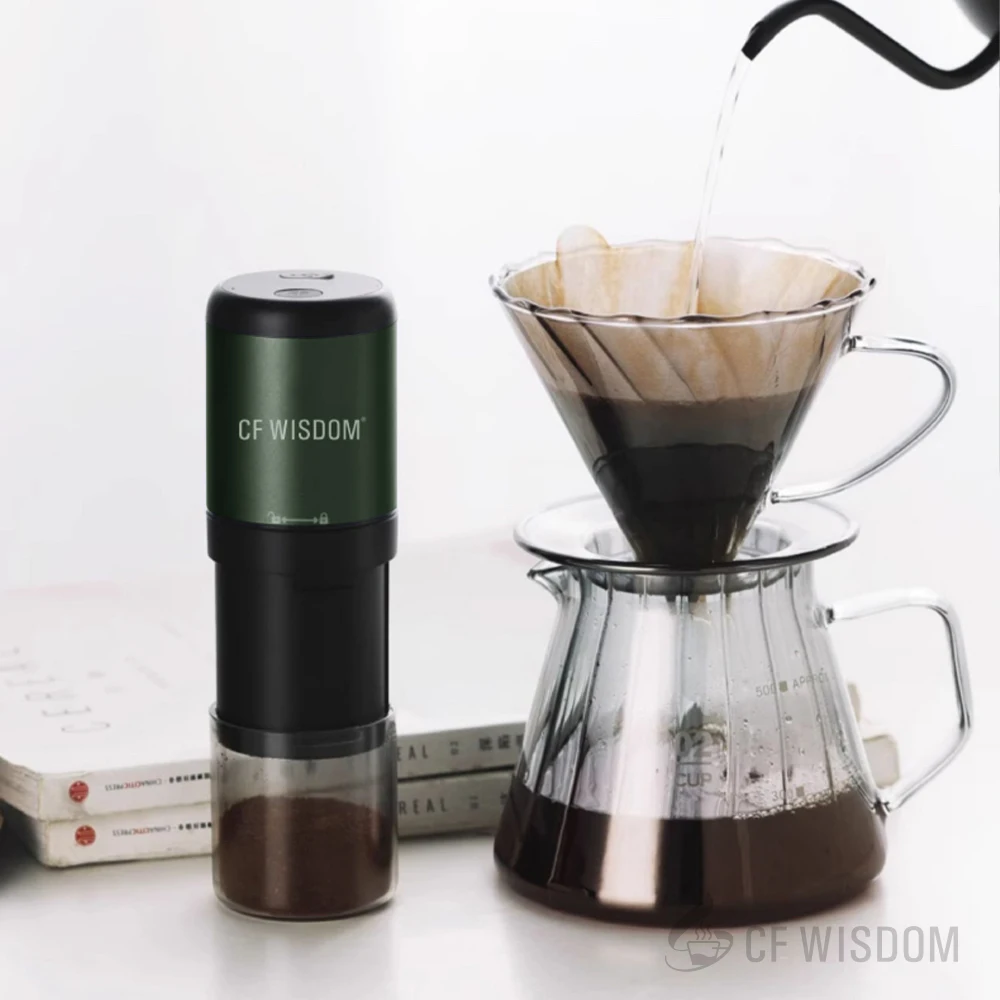
Recent technological advances have made portable electric grinders increasingly viable options for travelers. These compact devices offer convenience that appeals to many coffee enthusiasts, especially those with physical limitations or time constraints.
Advantages of Portable Electric Grinders:
– Minimal physical effort required
– Significantly faster grinding (typically 15-30 seconds vs. 1-2 minutes manually)
– Consistent speed regardless of bean hardness
– Ideal for users with hand strength issues or arthritis
Limitations to Consider:
– Larger size and weight compared to manual alternatives (typically 2-3x heavier)
– Dependence on battery life or power sources
– Higher noise levels that may be problematic in shared spaces
– Generally less grind consistency than premium manual options
– Higher price point for comparable quality
Modern portable coffee grinders with electric motors typically offer 20-30 brewing cycles per full charge. However, this can decrease significantly when grinding for espresso or when processing particularly dense, light-roasted beans.
Electric options excel in specific scenarios, particularly for:
– Users with mobility or strength limitations
– Settings where quick preparation is essential
– Situations where consistent power access is available
– Those preparing multiple servings simultaneously
When considering electric portable grinders, battery life and charging capabilities become crucial factors. Models with USB-C charging offer significant advantages for travelers, while those requiring proprietary chargers add an extra item to pack and potentially lose.
Top Manual Grinders for Travelers and Commuters
After extensive testing across multiple brewing methods and environments, these manual grinders stand out as exceptional choices for different travel needs:
Best Overall Portable Grinder
The ideal all-around travel grinder balances compact size with premium grinding capability. The best options in this category feature:
- Precision-machined steel burrs for exceptional consistency
- Compact design at approximately 6 inches tall
- Weight between 8-12 ounces
- 20-25g capacity (suitable for 1-2 servings)
- Full range of grind adjustments from espresso to French press
- Tool-free disassembly for cleaning
- Aircraft-grade aluminum construction
- Ergonomic fold-out handle that stows for transport
Testing revealed these top performers achieve 90%+ grind consistency at medium settings, with grinding times averaging 45-60 seconds for a 20g dose suitable for most pour-over methods.
Most Compact/Ultralight Option
When space and weight are your primary concerns:
- Ultra-compact cylindrical design under 5 inches tall
- Weight under 8 ounces
- Simplified adjustment mechanism
- 15-20g capacity
- Durable composite or lightweight metal construction
- Integrated folding handle
These minimalist grinders sacrifice some adjustment precision and grinding speed for exceptional portability, making them ideal for backpacking or ultra-light travel.
Best Value Portable Grinder
Value-focused options offer impressive performance without premium pricing:
- Ceramic or stainless steel burr sets
- Consistent performance at medium to coarse settings
- Plastic or aluminum/plastic hybrid construction
- Simple numbered adjustment system
- 20-25g capacity
- Weight around 10-12 ounces
These grinders achieve approximately 80-85% grind consistency – perfectly adequate for most brewing methods except espresso.
Most Durable for Outdoor Use
For adventurous brewing in challenging environments:
- Full stainless steel construction
- Weather-resistant design
- Reinforced burr mounting
- Stable base for grinding on uneven surfaces
- Enhanced grip surfaces for use with wet hands
- Higher capacity (25-30g) for group brewing scenarios
These rugged travel coffee grinders typically weigh slightly more (12-14 ounces) but deliver exceptional reliability in outdoor conditions where dust, humidity, and rough handling are concerns.
Electric Portable Options Worth Considering
For those who prioritize convenience or have physical limitations that make manual grinding challenging, these electric portable options offer compelling alternatives:
Compact Rechargeable Precision Grinder
This category leader offers an impressive balance of portability and performance:
Pros:
– USB-C rechargeable battery with 25-30 grinding cycles per charge
– 40mm steel conical burrs offering good consistency
– Electronic grind adjustment with 15 settings
– Relatively quiet operation (70-75 decibels)
– Magnetic catch cup with capacity for 20-25g
Cons:
– Weight approximately 1.5 pounds (2-3x heavier than premium manual options)
– 2-3 hour full charge time
– Higher price point than most manual grinders
– Not suitable for true espresso grinding
Ideal for: Extended travel with reliable charging access, office settings, and users with hand strength limitations.
Ultra-Compact Battery Powered Grinder
For maximum portability in an electric option:
Pros:
– Extremely compact design approaching manual grinder dimensions
– Integrated lithium-ion battery with USB charging
– 15-20 grinding cycles per charge
– Simple one-button operation
– Under 1 pound total weight
Cons:
– Blade grinding mechanism with less consistency than burr alternatives
– Limited capacity (12-15g maximum)
– Less durable construction than premium options
– Higher noise level during operation
Ideal for: Short trips, backup option, or situations where grinding effort must be minimized despite space constraints.
The market for high-quality travel coffee grinders continues to evolve, with manufacturers increasingly focusing on addressing the specific needs of coffee enthusiasts who refuse to compromise on quality while traveling.
Optimizing Your Beans for Travel
The grinder is only half the equation – properly selected and stored beans are equally crucial for exceptional travel coffee:
Bean Selection for Mobile Brewing:
– Choose medium to medium-dark roasts, which are more forgiving of variable brewing conditions
– Single-origin beans from Central and South America typically offer balanced flavor profiles that perform well across different water conditions
– Consider slightly darker roasts than you might use at home to compensate for potentially lower brewing temperatures
Preservation Strategies:
– Pre-portion beans into daily doses using small airtight containers or specialized coffee vials
– Vacuum-sealed single-serving packets eliminate air exposure until the moment of use
– Whole beans maintain freshness significantly longer than pre-ground coffee – up to 2-3 weeks in proper storage versus days for ground coffee
Environmental Considerations:
– Humidity is coffee’s enemy during travel – use containers with good moisture barriers
– Avoid storing beans in hotel refrigerators, as temperature fluctuations create condensation
– Shield beans from direct sunlight and heat sources, which accelerate flavor degradation
Many travelers find that manual coffee bean grinders with integrated storage compartments offer convenient all-in-one solutions, allowing you to carry precisely the amount of beans needed for your journey without additional containers.
Grind Size Mastery for Portable Brewing Methods
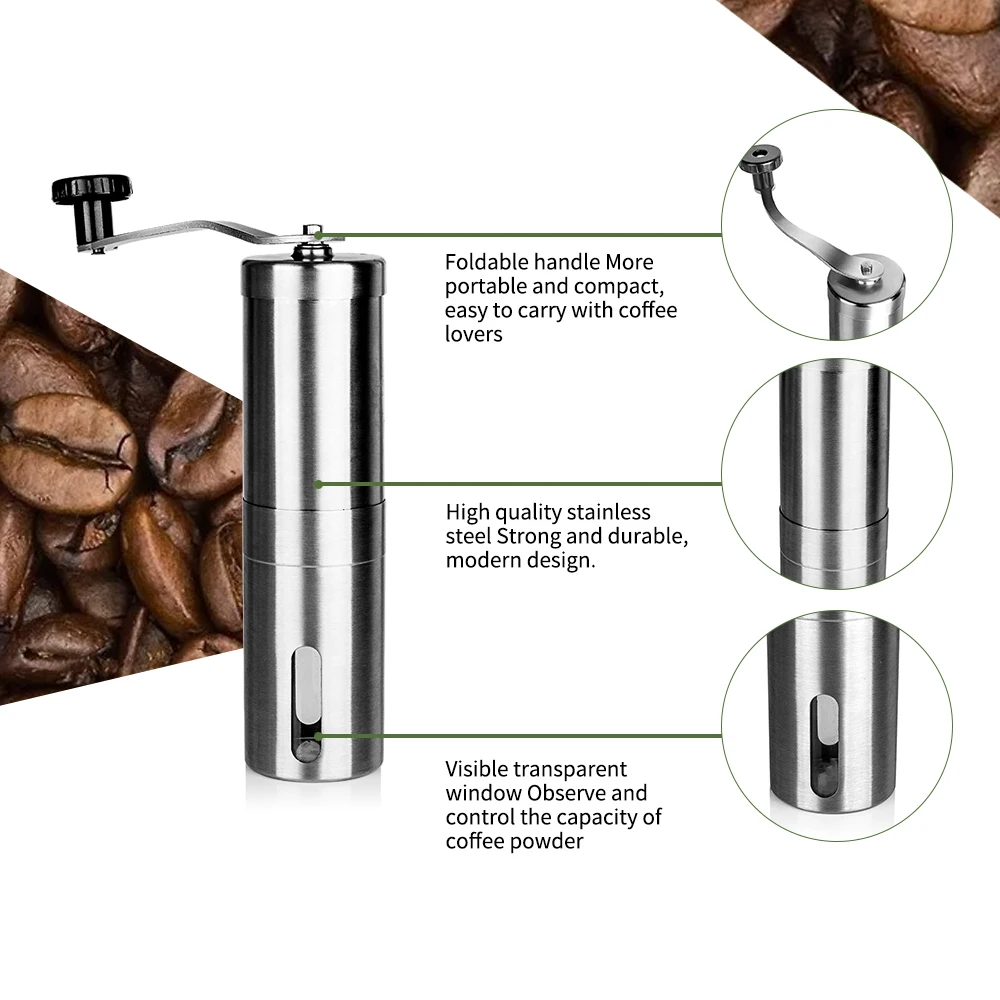
Achieving the perfect cup while traveling requires matching your grind size precisely to your brewing method. This becomes even more critical when dealing with variable water temperatures and brewing conditions away from home.
Grind Size Guide for Portable Brewers
| Brewing Method | Grind Size | Visual Comparison | Extraction Time |
|---|---|---|---|
| AeroPress (Standard) | Medium-Fine | Table salt | 1:30-2:00 min |
| AeroPress (Inverted) | Medium | Fine sand | 2:00-2:30 min |
| Travel Pour-Over | Medium | Sand | 2:30-3:30 min |
| Portable French Press | Medium-Coarse | Coarse sand | 4:00 min |
| Pocket Espresso Maker | Fine | Powder, slightly coarser than espresso | 30-45 sec |
| Collapsible Cold Brew | Coarse | Sea salt | 12-24 hours |
When traveling, you’ll often encounter variables that affect extraction and require grind adjustments:
Water Temperature Variations:
– Hotel water typically runs cooler than ideal brewing temperature
– For cooler water (175-185°F), use a slightly finer grind to aid extraction
– For very hot water (205°F+), adjust slightly coarser to prevent over-extraction
Troubleshooting Extraction Issues:
– Sour, weak coffee indicates under-extraction – adjust finer or increase brewing time
– Bitter, harsh coffee indicates over-extraction – adjust coarser or decrease brewing time
– Inconsistent results typically point to grind consistency problems – slow down manual grinding speed for more even results
Understanding how to grind coffee for AeroPress Go and other popular travel brewers gives you the flexibility to adapt to changing conditions while maintaining excellent results. The ability to adjust your grind precisely is one of the primary advantages of bringing your own grinder rather than relying on pre-ground coffee.
Mastering Manual Grinding Technique
Efficient manual grinding technique can transform a seemingly tedious task into a quick, almost meditative part of your brewing ritual. Proper approach reduces both time and effort required:
Optimal Body Positioning:
– Sit with the grinder between your knees for maximum stability
– For standing, place grinder on a flat surface at mid-torso height
– Hold the grinder body with your non-dominant hand to maintain stability
Efficient Hand Movement:
– Use full circular motions rather than partial turns
– Maintain consistent speed rather than rapid, irregular cranking
– Let momentum work to your advantage with smooth, continuous motion
– Switch hands if fatigue begins, rather than continuing with diminishing efficiency
Environment-Specific Adaptations:
– On airplane tray tables: Use your body to shield movement and reduce disturbance
– At campsites: Position between knees while seated for maximum stability
– In offices: Place a silicone mat under grinder to reduce noise and prevent slipping
Common issues like beans jamming typically result from cranking too quickly or applying uneven pressure. Most handheld coffee grinders perform best with steady, moderate-speed grinding rather than aggressive cranking.
With proper technique, even premium dense beans can be ground to pour-over consistency in under a minute for a single serving – far less time than seeking out a coffee shop while traveling.
Travel Maintenance: Keeping Your Grinder Clean on the Road
Maintaining your grinder while traveling doesn’t require elaborate equipment or procedures. A simple routine keeps your grinder performing at its best:
Daily Quick Clean (30 seconds):
1. After grinding, tap the grinder firmly to dislodge grounds
2. Briefly run the grinder empty to clear remaining particles
3. Wipe exterior surfaces with a dry cloth
4. For burrs, use a small brush (even a clean makeup brush works well)
Addressing Static Issues:
– Add 1-2 drops of water to beans before grinding (the “Ross Droplet Technique”)
– In very dry environments, briefly exhale into the empty grinder chamber before adding beans
– Tap the grinder firmly on a surface several times after grinding to dislodge statically-charged particles
Oil Management Without Disassembly:
– Grind a small amount of instant rice or specialty grinder cleaning pellets weekly to absorb oils
– For visible oil buildup, wipe accessible burr surfaces with a dry paper towel
– Avoid using liquid cleaners while traveling as they require complete drying
Recognizing when deeper cleaning is needed becomes intuitive – increased grinding resistance, visible residue, or flavor changes in your coffee are key indicators. Most coffee grinders need maintenance every 1-2 weeks during travel, though this varies with use frequency and coffee type.
Pack a small brush, microfiber cloth, and potentially a few grinder cleaning tablets for longer trips. These small items occupy minimal space but ensure consistent performance throughout your journey.
Smart Packing Strategies for Your Coffee Kit

Strategic packing protects your coffee equipment while maximizing limited space in your luggage:
Protection Methods by Luggage Type:
– For carry-on: Place grinder in a sock or dedicated protective case in the center of soft items
– For checked luggage: Wrap in clothing away from luggage edges to prevent impact damage
– For backpacks: Store in a hard container (like a plastic food container) for crush protection
Space Optimization:
– Nest your coffee gear whenever possible – store beans inside certain grinder chambers
– Use brewing devices that serve multiple functions (like AeroPress plungers storing coffee cups)
– Fill empty spaces in hollow equipment with small items like filters or cleaning tools
Weight Distribution:
– Place heavier metal grinders near the center of your luggage for better balance
– Distribute coffee gear weight between multiple bags for longer trips
Travel Considerations:
– Manual grinders are generally TSA-compliant in carry-on luggage
– Remove batteries from electric models when checking luggage
– Be prepared to demonstrate how manual grinders work if questioned by security
– Check specific airline policies for lithium battery restrictions in electric models
Many premium manual grinders fit perfectly in carry-on luggage and their solid construction protects them during transit. Their cylindrical shape typically integrates well with other packed items, making efficient use of limited space.
Beyond the Grinder: Essential Portable Brewing Companions
A complete mobile coffee kit pairs your portable grinder with carefully selected brewing tools:
Space-Efficient Brewing Devices:
– Collapsible silicone pour-over cones that flatten for packing
– Multi-function devices like the AeroPress that serve as brewer, measure, and storage container
– Compact immersion brewers that double as drinking vessels
Essential Accessories:
– Foldable digital scale (pocket-sized models under 2 oz)
– Collapsible kettles or immersion heaters for hotel use
– Reusable mesh filters that eliminate paper waste
– Heat-resistant travel mugs that serve as brewing vessels
Fine Adjustment Hand Grinder, Precision Manual Grinder, Travel Coffee Grinder
Price range: $185.11 through $494.63 Select options This product has multiple variants. The options may be chosen on the product pageHand Burr Grinder, Hand Crank Coffee Grinder, Manual Espresso Grinder, Portable Coffee Grinder
Price range: $262.72 through $300.22 Select options This product has multiple variants. The options may be chosen on the product pageManual Burr Mill, Manual Coffee Grinder Stainless Steel, Manual Coffee Mill Grinder, Mechanical Coffee Grinder
Price range: $127.26 through $130.32 Select options This product has multiple variants. The options may be chosen on the product pageHand Burr Grinder, Manual Coffee Grinder Stainless Steel, Precision Manual Grinder
Price range: $183.64 through $187.52 Select options This product has multiple variants. The options may be chosen on the product page
The ideal travel kit balances completeness with portability. Many compact coffee mills are designed specifically to pair with popular travel brewers, creating integrated systems that pack efficiently while delivering exceptional coffee.
When fully assembled, a complete travel coffee kit including grinder, brewer, and accessories typically weighs between 1-2 pounds and fits easily in a small packing cube or dedicated coffee carry case.
When You’re Without a Grinder: Emergency Alternatives
Even dedicated coffee enthusiasts occasionally find themselves without access to their grinder. While no alternative matches a proper burr grinder’s results, these emergency methods can help in a pinch:
Important Note: These alternatives significantly compromise grind consistency and extraction quality. Use only when proper grinding equipment is unavailable.
Ziplock Bag and Blunt Object Method:
1. Place a small amount of beans (10-15g) in a heavy-duty ziplock bag
2. Remove excess air and seal completely
3. Wrap in a towel to prevent punctures
4. Crush gently with a flat object (book, pan bottom)
5. Check frequently and continue until desired coarseness is achieved
6. Expect very inconsistent results – this works best for immersion methods like French press
Leveraging Available Kitchen Tools:
– Blenders on pulse setting can substitute for blade grinders (though with poor consistency)
– Mortar and pestle can work for small quantities, focusing on crushing rather than grinding
– Food processors produce extremely inconsistent results but can work for French press in emergencies
Pre-Grinding Strategy:
When you know a grinder won’t be available, pre-grind beans and store in small airtight containers. While not ideal, freshly pre-ground coffee used within 1-2 days is vastly superior to typical store-bought pre-ground options.
Finding Your Perfect Portable Coffee Solution
Selecting the ideal portable coffee setup depends on balancing several personal factors:
Decision Framework:
Primary Use Environment
– Office: Prioritize quiet operation and cleanliness
– Outdoor/Adventure: Emphasize durability and weatherproofing
– Frequent Travel: Focus on weight and compactness
– Mixed Use: Seek versatility between home and travelPreferred Brewing Methods
– Pour-over: Requires precise medium grind consistency
– Immersion (French press, AeroPress): More forgiving of grind variation
– Espresso-style: Demands highly capable grinders with fine adjustmentPhysical Considerations
– Hand strength limitations may necessitate electric options
– Weight restrictions might eliminate certain premium metal grinders
– Space constraints could rule out larger capacity optionsUsage Frequency
– Daily use justifies higher investment in durability
– Occasional use might prioritize compact storage over performance
For those interested in brewing espresso-style drinks while traveling, understanding the ultimate espresso grind size chart is particularly important, as this brewing method requires the most precise grind control.
Optimal Setups for Common Scenarios:
- Frequent Business Traveler: Premium compact manual grinder with integrated storage, paired with an AeroPress and collapsible electric kettle
- Outdoor Enthusiast: Durable all-metal manual grinder with wide base stability, paired with a French press brewing mug
- Digital Nomad: Mid-size electric grinder with good battery life, paired with a pour-over dripper and scale for daily use in temporary accommodations
Frequently Asked Questions
Can coffee grinders be carried in airplane hand luggage?
Yes, manual coffee grinders are TSA-compliant and can be carried in hand luggage. Electric grinders with lithium batteries may face restrictions – check with your specific airline for current policies.
What’s the smallest coffee grinder that still delivers good results?
The smallest effective grinders are typically cylindrical manual models around 6 inches tall and 2 inches in diameter, weighing 8-10 ounces. While ultra-compact options exist, those under 5 inches generally compromise significantly on grind quality or capacity.
How do you clean a grinder without running water?
Use grinder cleaning tablets or instant rice to absorb oils and remove residue. Wipe accessible parts with a dry microfiber cloth, and use a small brush to remove grounds from crevices. Save deep cleaning for when you have proper facilities.
Are portable electric grinders worth the extra cost and weight?
For most travelers, manual grinders offer better value, performance and reliability. Electric models make sense primarily for those with physical limitations or when preparing coffee for multiple people regularly.
What beans work best for travel brewing?
Medium roasts from Central and South America typically perform most consistently across variable travel conditions. Fresh beans are paramount, but slightly darker roasts than you might use at home often compensate better for suboptimal brewing temperatures.
How long does manual grinding actually take?
With proper technique, grinding 20g of beans (enough for a single cup) takes 45-60 seconds with a quality manual grinder. Grinding for espresso takes longer (60-90 seconds) while coarse grinding for French press is quicker (30-45 seconds).

